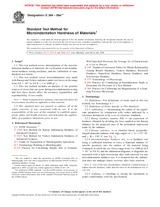We need your consent to use the individual data so that you can see information about your interests, among other things. Click "OK" to give your consent.
ASTM E384-08ae1
Standard Test Method for Microindentation Hardness of Materials (Includes all amendments And changes 12/31/2010).
Automatically translated name:
Standard Test Method for Microindentation Hardness of Materials
STANDARD published on 15.3.2008
The information about the standard:
Designation standards: ASTM E384-08ae1
Note: WITHDRAWN
Publication date standards: 15.3.2008
SKU: NS-46600
The number of pages: 33
Approximate weight : 99 g (0.22 lbs)
Country: American technical standard
Category: Technical standards ASTM
Annotation of standard text ASTM E384-08ae1 :
Keywords:
hardness, indentation, Knoop, microindentation, Vickers, Abb´,e-Nelson illumination, Calibration--metals/alloys analysis instrumentation, Hardness (indentation)--microhardness, Indenter geometry, Knoop hardness (HK) number, Kohler illumination, Metallic hardness, Metals and metallic materials, Repeatability/reproducibility (RR), Structural metals/alloys, Verification, Vickers hardness (HV), ICS Number Code 19.060 (Mechanical testing)
Additional information
| Significance and Use | ||||||||||||||||||||||||||
|
Hardness tests have been found to be very useful for materials evaluation, quality control of manufacturing processes and research and development efforts. Hardness, although empirical in nature, can be correlated to tensile strength for many metals, and is an indicator of wear resistance and ductility. Microindentation tests extend hardness testing to materials too thin or too small for macroindentation tests. Microindentation tests allow specific phases or constituents and regions or gradients too small for macroindentation testing to be evaluated. Because the microindentation hardness will reveal hardness variations that may exist within a material, a single test value may not be representative of the bulk hardness. |
||||||||||||||||||||||||||
| 1. Scope | ||||||||||||||||||||||||||
|
1.1 This test method covers determination of the microindentation hardness of materials, the verification of microindentation hardness testing machines, and the calibration of standardized test blocks. 1.2 This test method covers microindentation tests made with Knoop and Vickers indenters under test forces in the range from 9.8 × 10-3 to 9.8 N ( 1 to 1000 gf ). 1.3 This test method includes an analysis of the possible sources of errors that can occur during microindentation testing and how these factors affect the accuracy, repeatability, and reproducibility of test results. Note 1—While Committee E04 is primarily concerned with metals, the test procedures described are applicable to other materials. 1.4 This standard does not purport to address all of the safety concerns, if any, associated with its use. It is the responsibility of the user of this standard to establish appropriate safety and health practices and determine the applicability of regulatory limitations prior to use. |
||||||||||||||||||||||||||
| 2. Referenced Documents | ||||||||||||||||||||||||||
|
We recommend:
Technical standards updating
Do you want to make sure you use only the valid technical standards?
We can offer you a solution which will provide you a monthly overview concerning the updating of standards which you use.
Would you like to know more? Look at this page.




 Cookies
Cookies
